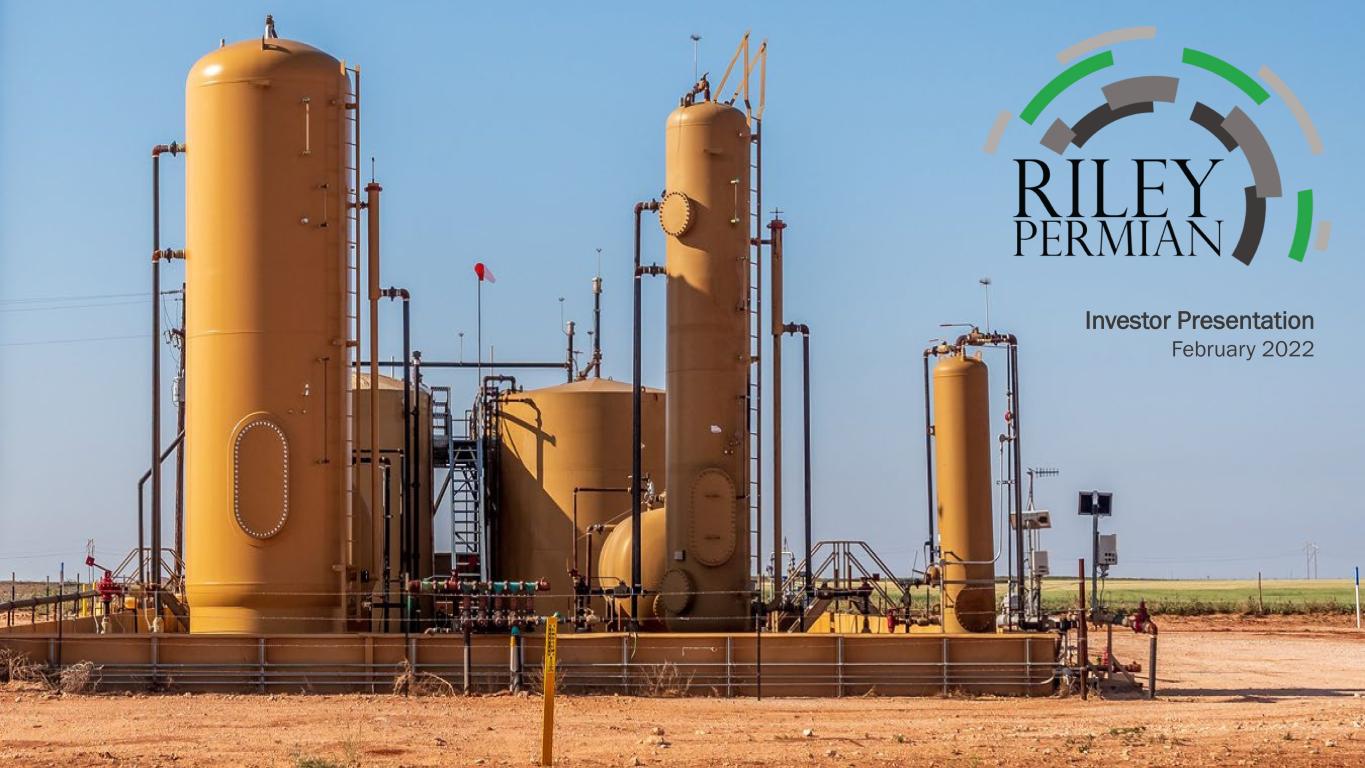
Investor Presentation February 2022

2 Forward-Looking Statements Forward-Looking Statements This presentation contains projections and other forward-looking statements within the meaning of federal securities laws. These projections and statements reflect Riley Exploration Permian, Inc.’s (“Riley Permian”) current views with respect to future events and financial performance. No assurances can be given, however, that these events will occur or that these projections will be achieved, and actual results could differ materially from those projected as a result of certain factors. A discussion of these factors is included in Riley Permian’s periodic reports filed with the U.S. Securities and Exchange Commission (“SEC”). All statements, other than historical facts, that address activities that Riley Permian assumes, plans, expects, believes, intends or anticipates (and other similar expressions) will, should or may occur in the future are forward-looking statements. The forward-looking statements are based on management’s current beliefs, based on currently available information, as to the outcome and timing of future events, including the volatility of oil, natural gas and NGL prices; the scope, duration, and reoccurrence of any epidemics or pandemics (including, specifically, the coronavirus disease 2019 (COVID-19) pandemic and any related variants), including reactive or proactive measures taken by governments, regulatory agencies and businesses related to the pandemic, and the effects of COVID-19 on the oil and natural gas industry, pricing and demand for oil and natural gas and supply chain logistics; regional supply and demand factors, any delays, curtailment delays or interruptions of production, and any governmental order, rule or regulation that may impose production limits; cost and availability of gathering, pipeline, refining, transportation and other midstream and downstream activities; severe weather and other risks that lead to a lack of any available markets; our ability to successfully complete mergers, acquisitions and divestitures; the risk that the Company's EOR project may not perform as expected or produce the anticipated benefits; risks relating to our operations, including development drilling and testing results and performance of acquired properties and newly drilled wells; any reduction in our borrowing base on our revolving credit facility from time to time and our ability to repay any excess borrowings as a result of such reduction; the impact of our derivative strategy and the results of future settlement; our ability to comply with the financial covenants contained in our credit agreement; conditions in the capital, financial and credit markets and our ability to obtain capital needed for development and exploration operations on favorable terms or at all; the loss of certain tax deductions; risks associated with executing our business strategy, including any changes in our strategy; inability to prove up undeveloped acreage and maintain production on leases; risks associated with concentration of operations in one major geographic area; legislative or regulatory changes, including initiatives related to hydraulic fracturing, emissions, and disposal of produced water, which may be negatively impacted by regulation or legislation; the ability to receive drilling and other permits or approvals and rights-of-way in a timely manner (or at all), which may be restricted by governmental regulation and legislation; risks related to litigation; evolving geopolitical and military hostilities in other areas of the world; and cybersecurity threats, technology system failures and data security issues. These forward-looking statements involve certain risks and uncertainties that could cause the results to differ materially from those expected by the management of Riley Permian. These forward-looking statements involve significant risks and uncertainties that could cause actual results to differ materially from those anticipated, including, but not limited to, the risk that Riley Permian may reduce, suspend or totally eliminate dividend payments in the future, whether variable or fixed, due to insufficient liquidity or other factors, potential adverse reactions or changes to the business or operations of Riley Permian resulting from the recently completed merger, including Riley Permian’s future financial condition, results of operations, strategy and plans; changes in capital markets and the ability of Riley Permian to finance operations in the manner expected; the risk that the Company’s EOR and CCUS projects may not perform as expected or produce the anticipated benefits; the risks of oil and gas activities; and the fact that operating costs and business disruption may be greater than expected following the consummation of the merger. Riley Permian encourages readers to consider the risks and uncertainties associated with projections and other forward-looking statements. In addition, Riley Permian assumes no obligation to publicly revise or update any forward-looking statements based on future events or circumstances. For additional discussion of the factors that may cause us not to achieve our financial projections and/or production estimates, see Riley Permian’s filings with the SEC, including its forms 10-K, 10-Q and 8-K and any amendments thereto. We do not undertake any obligation to release publicly the results of any future revisions we may make to this prospective data or to update this prospective data to reflect events or circumstances after the date of this presentation. Therefore, you are cautioned not to place undue reliance on this information. None of the information contained in this presentation has been audited by any independent auditor. This presentation is prepared as a convenience for securities analysts and investors and may be useful as a reference tool. Riley Permian may elect to modify the format or discontinue publication at any time, without notice to securities analysts or investors. Use of non-GAAP Financial Information This presentation includes certain financial measures that are not calculated in accordance with U.S. generally accepted accounting principles (“GAAP”). These measures include (i) Adjusted Net Income, (ii) Adjusted EBITDAX, (iii) Cash Margins and (iv) Free Cash Flow. These non-GAAP financial measures are not measures of financial performance prepared or presented in accordance with GAAP and may exclude items that are significant in understanding and assessing our financial results. Therefore, these measures should not be considered in isolation, and users of any such information should not place undue reliance thereon. See the Appendix for the descriptions and reconciliations of these non-GAAP measures presented in this presentation to the most directly comparable financial measures calculated in accordance with GAAP. Oil & Gas Reserves The SEC generally permits oil and natural gas companies, in filings made with the SEC, to disclose proved reserves, which are reserve estimates that geological and engineering data demonstrate with reasonable certainty to be recoverable in future years from known reservoirs under existing economic and operating conditions, and certain probable and possible reserves that meet the SEC’s definitions for such terms. In this presentation, Riley Permian may use the terms “resource potential,” “resource play,” “estimated ultimate recovery,” or “EURs,” “type curve” and “standardized measure,” each of which the SEC guidelines restrict from being included in filings with the SEC without strict compliance with SEC definitions. These terms refer to Riley Permian’s internal estimates of unbooked hydrocarbon quantities that may be potentially discovered through exploratory drilling or recovered with additional drilling or recovery techniques. “Resource potential” is used by Riley Permian to refer to the estimated quantities of hydrocarbons that may be added to proved reserves, largely from a specified resource play potentially supporting numerous drilling locations. A “resource play” is a term used by Riley Permian to describe an accumulation of hydrocarbons known to exist over a large areal expanse and/or thick vertical section potentially supporting numerous drilling locations, which, when compared to a conventional play, typically has a lower geological and/or commercial development risk. “EURs” are based on Riley Permian’s previous operating experience in a given area and publicly available information relating to the operations of producers who are conducting operations in these areas. Unbooked resource potential or “EURs” do not constitute reserves within the meaning of the Society of Petroleum Engineer’s Petroleum Resource Management System or SEC rules and do not include any proved reserves. Actual quantities of reserves that may be ultimately recovered from Riley Permian’s interests may differ substantially from those presented herein. Factors affecting ultimate recovery include the scope of Riley Permian’s ongoing drilling program, which will be directly affected by the availability of capital, decreases in oil, natural gas liquids and natural gas prices, well spacing, drilling and production costs, availability and cost of drilling services and equipment, lease expirations, transportation constraints, regulatory approvals, negative revisions to reserve estimates and other factors, as well as actual drilling results, including geological and mechanical factors affecting recovery rates. “EURs” from reserves may change significantly as development of Riley Permian’s core assets provides additional data. In addition, Riley Permian’s production forecasts and expectations for future periods are dependent upon many assumptions, including estimates of production decline rates from existing wells and the undertaking and outcome of future drilling activity, which may be affected by significant commodity price declines or drilling cost increases. “Type curve” refers to a production profile of a well, or a particular category of wells, for a specific play and/or area.
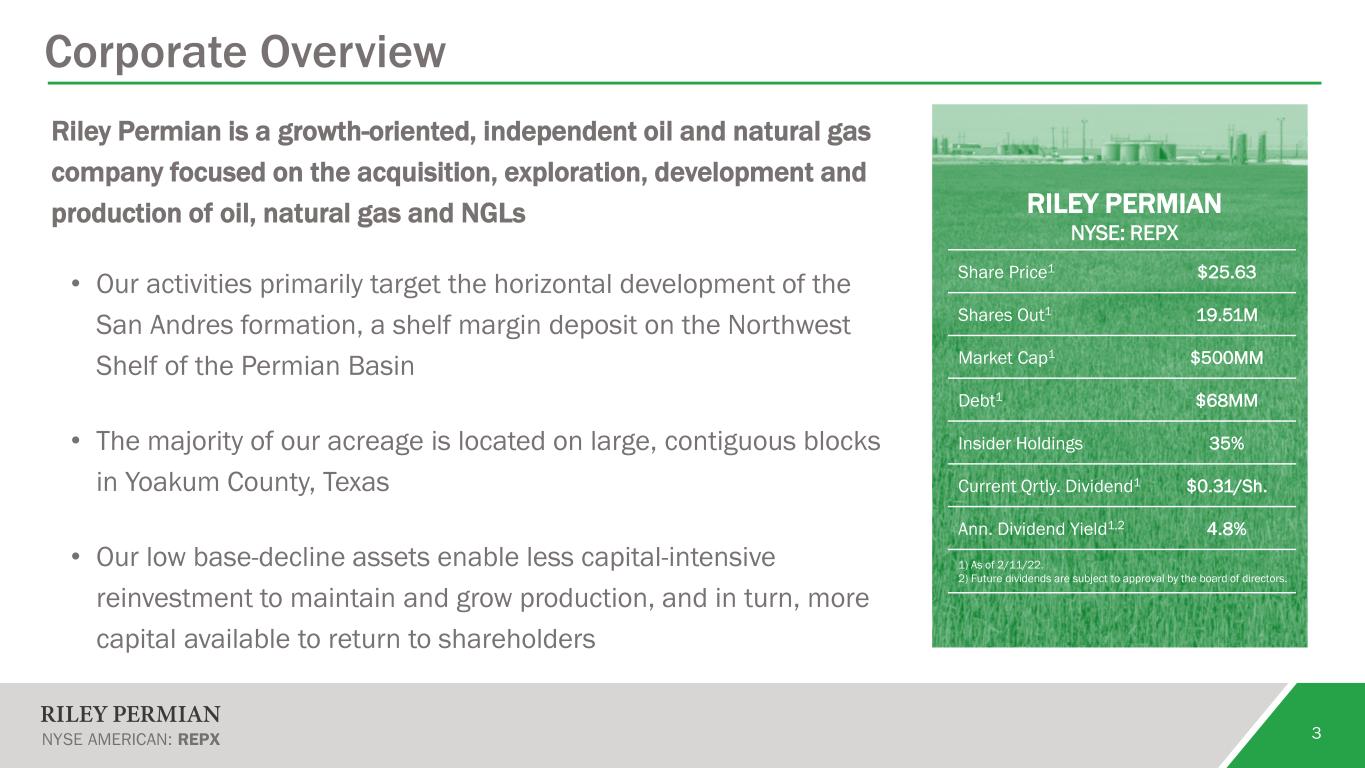
Corporate Overview Riley Permian is a growth-oriented, independent oil and natural gas company focused on the acquisition, exploration, development and production of oil, natural gas and NGLs • Our activities primarily target the horizontal development of the San Andres formation, a shelf margin deposit on the Northwest Shelf of the Permian Basin • The majority of our acreage is located on large, contiguous blocks in Yoakum County, Texas • Our low base-decline assets enable less capital-intensive reinvestment to maintain and grow production, and in turn, more capital available to return to shareholders 3 RILEY PERMIAN NYSE: REPX Share Price1 $25.63 Shares Out1 19.51M Market Cap1 $500MM Debt1 $68MM Insider Holdings 35% Current Qrtly. Dividend1 $0.31/Sh. Ann. Dividend Yield1,2 4.8% 1) As of 2/11/22. 2) Future dividends are subject to approval by the board of directors.
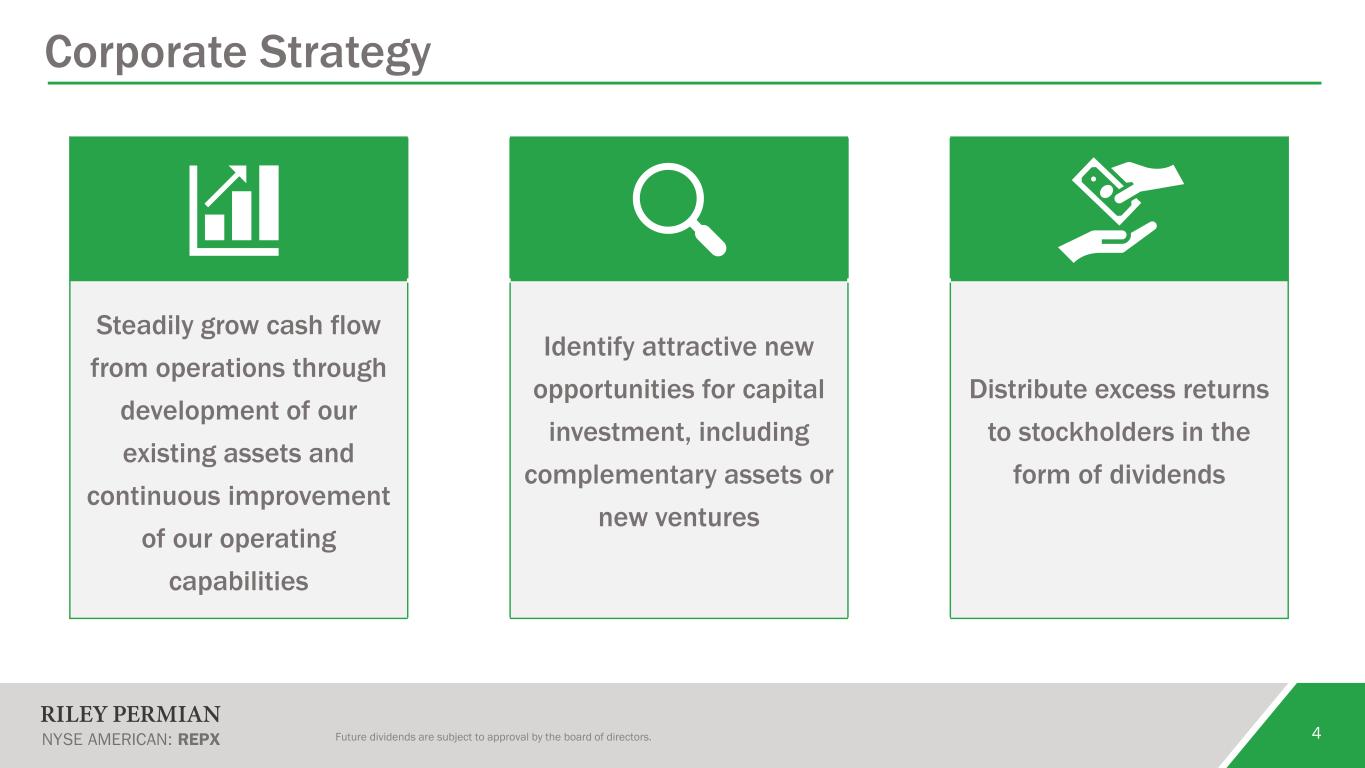
Corporate Strategy 4Future dividends are subject to approval by the board of directors. Steadily grow cash flow from operations through development of our existing assets and continuous improvement of our operating capabilities Identify attractive new opportunities for capital investment, including complementary assets or new ventures Distribute excess returns to stockholders in the form of dividends
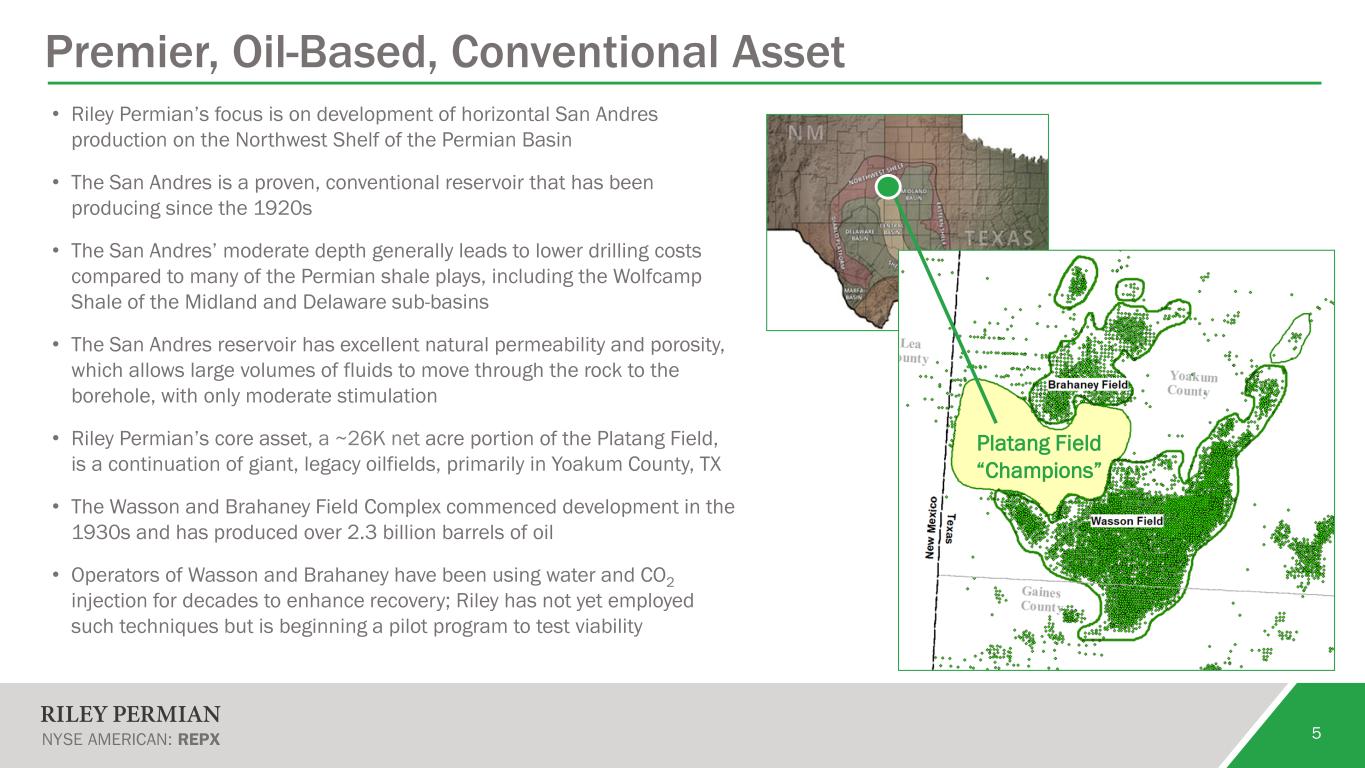
Premier, Oil-Based, Conventional Asset 5 • Riley Permian’s focus is on development of horizontal San Andres production on the Northwest Shelf of the Permian Basin • The San Andres is a proven, conventional reservoir that has been producing since the 1920s • The San Andres’ moderate depth generally leads to lower drilling costs compared to many of the Permian shale plays, including the Wolfcamp Shale of the Midland and Delaware sub-basins • The San Andres reservoir has excellent natural permeability and porosity, which allows large volumes of fluids to move through the rock to the borehole, with only moderate stimulation • Riley Permian’s core asset, a ~26K net acre portion of the Platang Field, is a continuation of giant, legacy oilfields, primarily in Yoakum County, TX • The Wasson and Brahaney Field Complex commenced development in the 1930s and has produced over 2.3 billion barrels of oil • Operators of Wasson and Brahaney have been using water and CO2 injection for decades to enhance recovery; Riley has not yet employed such techniques but is beginning a pilot program to test viability Platang Field “Champions”

Lower Decline Rate in Wells Relative to Shale Enables Distributed Allocation of Capital Use Allowing for Growth, Dividend Payments and Excess Cash Flow Comparison of Initial Decline Rates for Representative Riley Permian Wells vs Shale Wells1 Cumulative Allocation of Riley Permian’s CFFO2 for FY21 through 9/30/21 Capex3 22% Y-o-Y, organic production growth4 Dividends5 4.8% current dividend yield5 Excess Used to repay debt during FY21 (0.7x leverage6) 6 Low Decline Rates Enable Capital Efficiency (1) Riley Permian wells include representative well set from 2018 vintage. Permian Shale wells include wells from 2018 vintage; producing formations limited to Wolfcamp, Wolfbone and Bone Spring; counties limited to Eddy, Glassock, Howard, Lea, Loving, Martin, Midland, Reagan, Reeves, Upton, Ward and Winkler. Cumulative production normalized to 7,200’ lateral length. Source: Public ShaleProfile.com. (2) Cash Flow from Continuing Operations. (3) Total cash capital expenditures before acquisitions, for the twelve months ending 9/30/21. (4) Fiscal year 2021 vs. fiscal year 2020. (5) Future dividends are subject to approval by the board of directors. Yield based on share price as of 2/11/22. (6) Non-GAAP financial measure. Total leverage calculated as gross debt outstanding as of 2/11/22 divided by last twelve months Adjusted EBITDAX, which was $97.3MM for the period ending December 31, 2021. 0% 20% 40% 60% 80% 100% 1 11 21 31 % o f P ea k M on th P ro du ct io n Months Riley Shale 70% 21% 9%
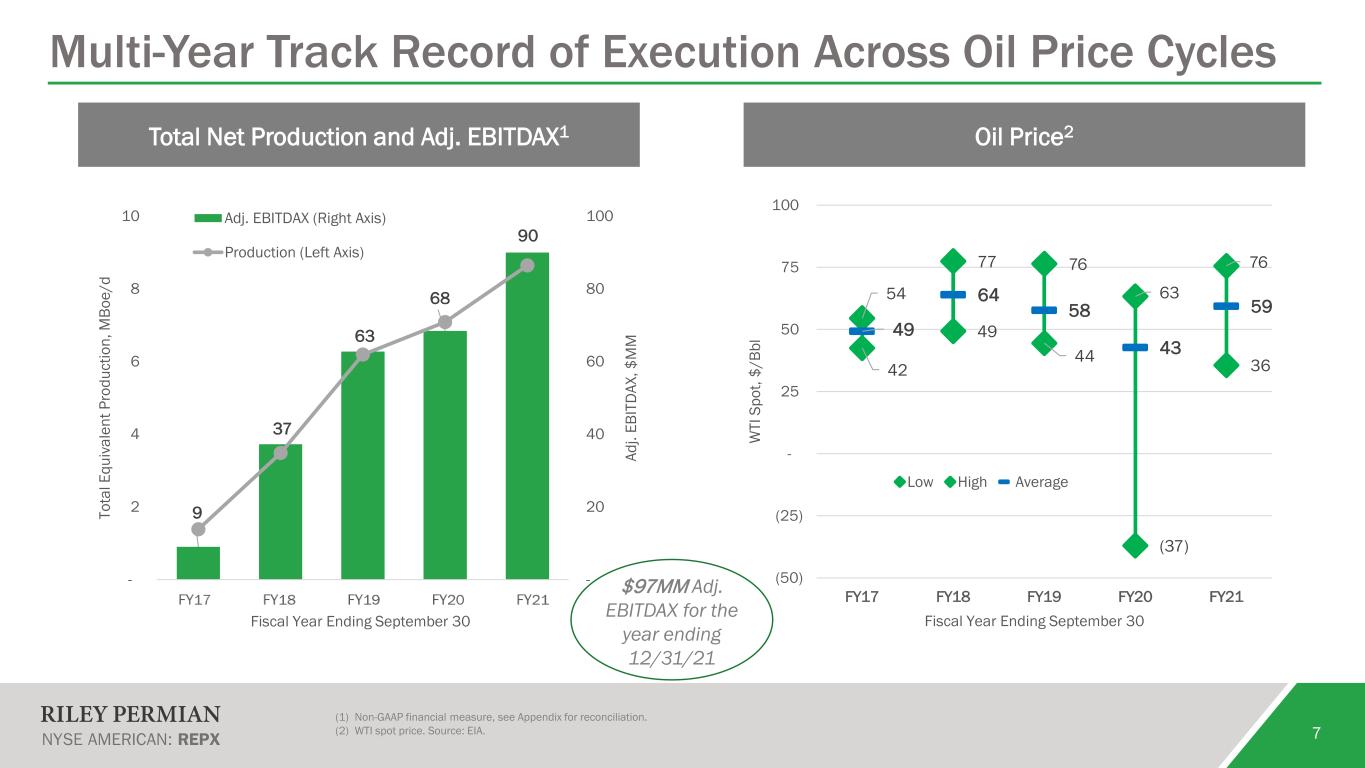
9 37 63 68 90 - 20 40 60 80 100 - 2 4 6 8 10 1 2 3 4 5 Ad j. EB IT D AX , $ M M To ta l E qu iv al en t P ro du ct io n, M Bo e/ d Adj. EBITDAX (Right Axis) Production (Left Axis) Total Net Production and Adj. EBITDAX1 Oil Price2 7 Multi-Year Track Record of Execution Across Oil Price Cycles (1) Non-GAAP financial measure, see Appendix for reconciliation. (2) WTI spot price. Source: EIA. 42 49 44 (37) 36 54 77 76 63 76 49 64 58 43 59 (50) (25) - 25 50 75 100 FY17 FY18 FY19 FY20 FY21 W TI S po t, $/ Bb l Low High Average $97MM Adj. EBITDAX for the year ending 12/31/21 Fiscal Year Ending September 30 Fiscal Year Ending September 30
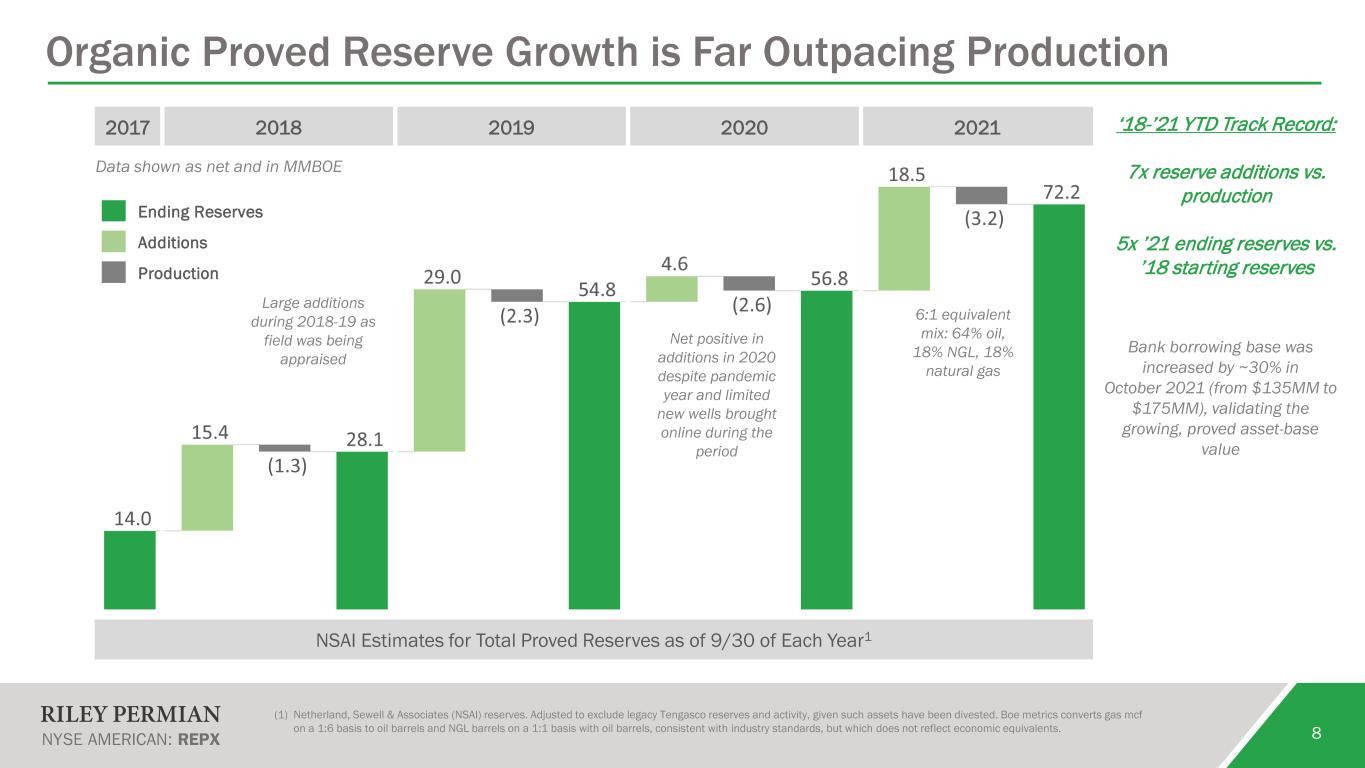
2017 2018 2019 2020 2021 NSAI Estimates for Total Proved Reserves as of 9/30 of Each Year1 Organic Proved Reserve Growth is Far Outpacing Production 8 (1) Netherland, Sewell & Associates (NSAI) reserves. Adjusted to exclude legacy Tengasco reserves and activity, given such assets have been divested. Boe metrics converts gas mcf on a 1:6 basis to oil barrels and NGL barrels on a 1:1 basis with oil barrels, consistent with industry standards, but which does not reflect economic equivalents. Bank borrowing base was increased by ~30% in October 2021 (from $135MM to $175MM), validating the growing, proved asset-base value 6:1 equivalent mix: 64% oil, 18% NGL, 18% natural gas Net positive in additions in 2020 despite pandemic year and limited new wells brought online during the period ‘18-’21 YTD Track Record: 7x reserve additions vs. production 5x ’21 ending reserves vs. ’18 starting reserves Large additions during 2018-19 as field was being appraised Ending Reserves Additions Production Data shown as net and in MMBOE
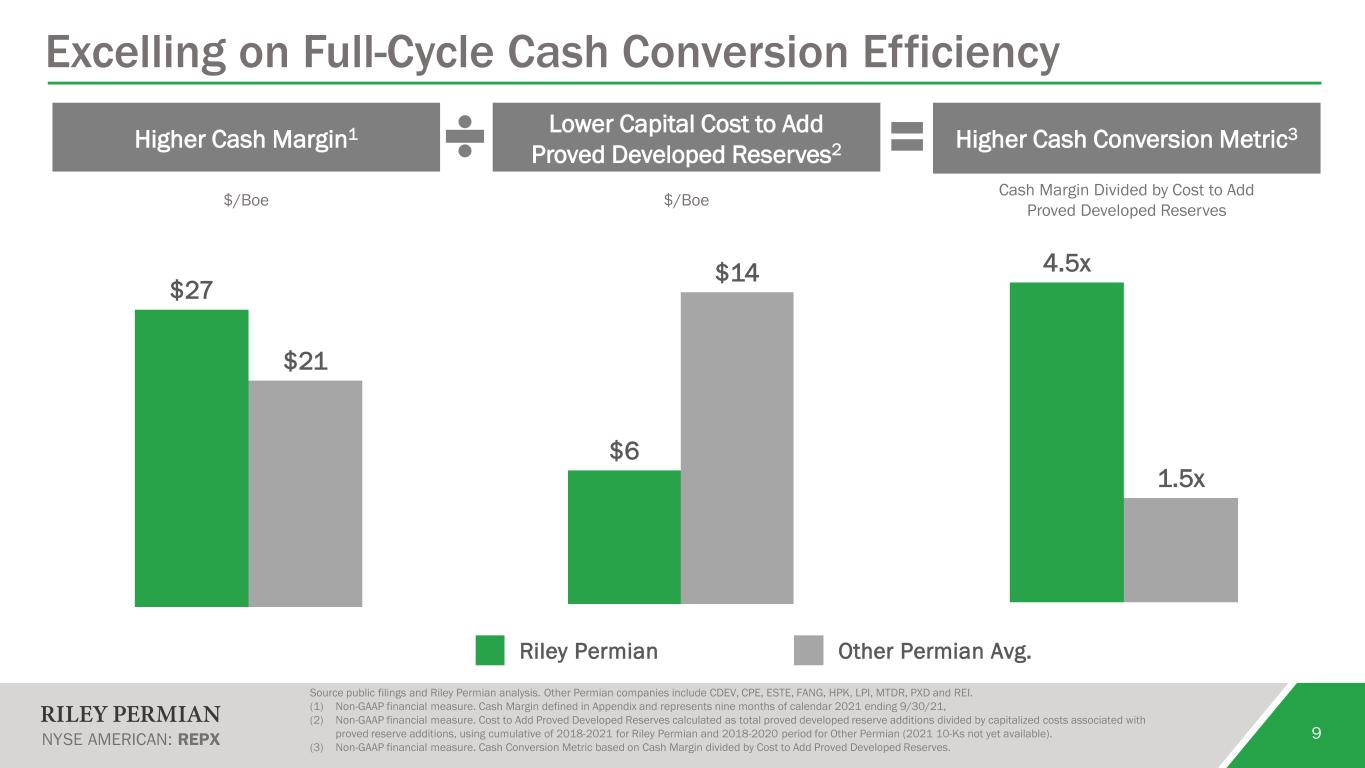
Higher Cash Margin1 Lower Capital Cost to Add Proved Developed Reserves2 Higher Cash Conversion Metric3 $/Boe $/Boe Cash Margin Divided by Cost to Add Proved Developed Reserves 4.5x 1.5x 9 Source public filings and Riley Permian analysis. Other Permian companies include CDEV, CPE, ESTE, FANG, HPK, LPI, MTDR, PXD and REI. (1) Non-GAAP financial measure. Cash Margin defined in Appendix and represents nine months of calendar 2021 ending 9/30/21, (2) Non-GAAP financial measure. Cost to Add Proved Developed Reserves calculated as total proved developed reserve additions divided by capitalized costs associated with proved reserve additions, using cumulative of 2018-2021 for Riley Permian and 2018-2020 period for Other Permian (2021 10-Ks not yet available). (3) Non-GAAP financial measure. Cash Conversion Metric based on Cash Margin divided by Cost to Add Proved Developed Reserves. Excelling on Full-Cycle Cash Conversion Efficiency $27 $21 Riley Permian Other Permian Avg. $6 $14

10 Revised Hedging Strategy with Improving Realized Price Profile Based on derivative positions as of February 11, 2022. See Appendix for detail. (1) Two hedging requirements per the Company’s credit facility, including (i) a minimum of 50% of forecasted PDP volumes over the coming 24 months (which does not require each individual month to be hedged > 50%, and (ii) a minimum of 24 months in total (number of months) 1. During 2021 the Company was significantly hedged (>80% of production) at $50-55 per barrel; 2022 may represent a transitional year with materially lower hedge volumes and increasing amounts of unhedged volumes at market prices 2. In the current environment, the Company plans to be less hedged overall relative to the past, with relatively higher amounts of hedging for production forecasted within a rolling 12-month basis and less hedging beyond, which may allow for hedge price optimization in a backwardated market 3. Only two new oil price hedges have been added over the past 6 months, allowing existing hedges to roll off, while ensuring bank compliance: a. Calendar Q3 2022, two-way costless collars for 27 MBbls total (<4% of recent quarter production) with a floor price of $45 and ceiling of $115 b. Calendar Q1 2024, two-way costless collars for 3 MBbls total (0.4% of recent quarter production) with a floor of $50 and ceiling of $88 4. Percentages shown at right are based off actual calendar Q4 2021 production; growth beyond such levels, per the Company’s plan, would suggest lower hedged percentages Riley Permian will utilize commodity price hedges to manage fixed cost exposure and to comply with bank covenant requirements(1), while maintaining unhedged production for potential upside exposure and operating flexibility 83% 65% 65% 58% 54% 34% 29% 22% 22% 0.4% 17% 35% 35% 42% 46% 66% 71% 78% 78% 99.6% $52 $54 $54 $57 $53 $54 $54 $53 $53 $88 $45 $55 $65 $75 $85 $95 0% 20% 40% 60% 80% 100% Q4 2021 (A) Q1 2022 Q2 2022 Q3 2022 Q4 2022 Q1 2023 Q2 2023 Q3 2023 Q4 2023 Q1 2024 He dg e Pr ic e He dg e Vo lu m es a s a % o f Ca le nd ar 4 Q 21 A ct ua l P ro du ct io n Hedge % Unhedged Downside Protection Upside Participation
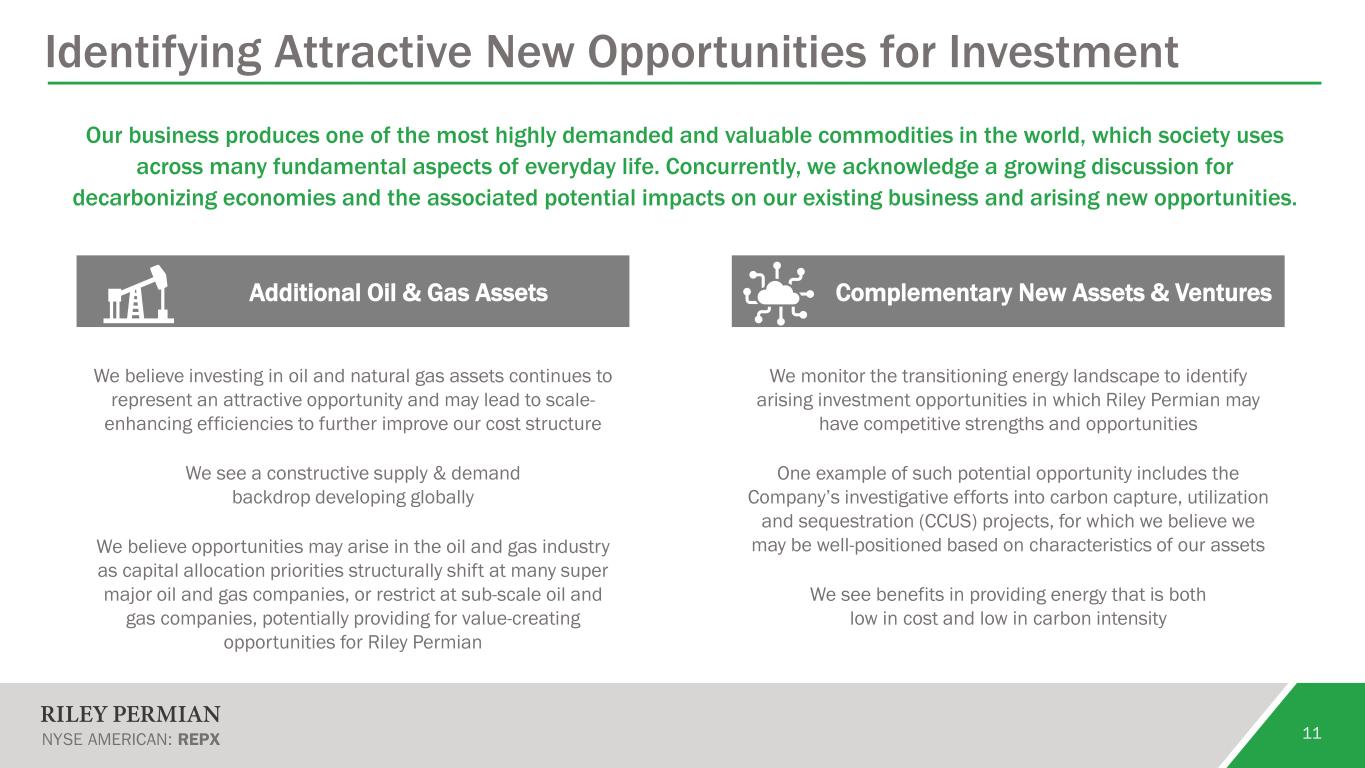
Identifying Attractive New Opportunities for Investment 11 Our business produces one of the most highly demanded and valuable commodities in the world, which society uses across many fundamental aspects of everyday life. Concurrently, we acknowledge a growing discussion for decarbonizing economies and the associated potential impacts on our existing business and arising new opportunities. Additional Oil & Gas Assets Complementary New Assets & Ventures We believe investing in oil and natural gas assets continues to represent an attractive opportunity and may lead to scale- enhancing efficiencies to further improve our cost structure We see a constructive supply & demand backdrop developing globally We believe opportunities may arise in the oil and gas industry as capital allocation priorities structurally shift at many super major oil and gas companies, or restrict at sub-scale oil and gas companies, potentially providing for value-creating opportunities for Riley Permian We monitor the transitioning energy landscape to identify arising investment opportunities in which Riley Permian may have competitive strengths and opportunities One example of such potential opportunity includes the Company’s investigative efforts into carbon capture, utilization and sequestration (CCUS) projects, for which we believe we may be well-positioned based on characteristics of our assets We see benefits in providing energy that is both low in cost and low in carbon intensity
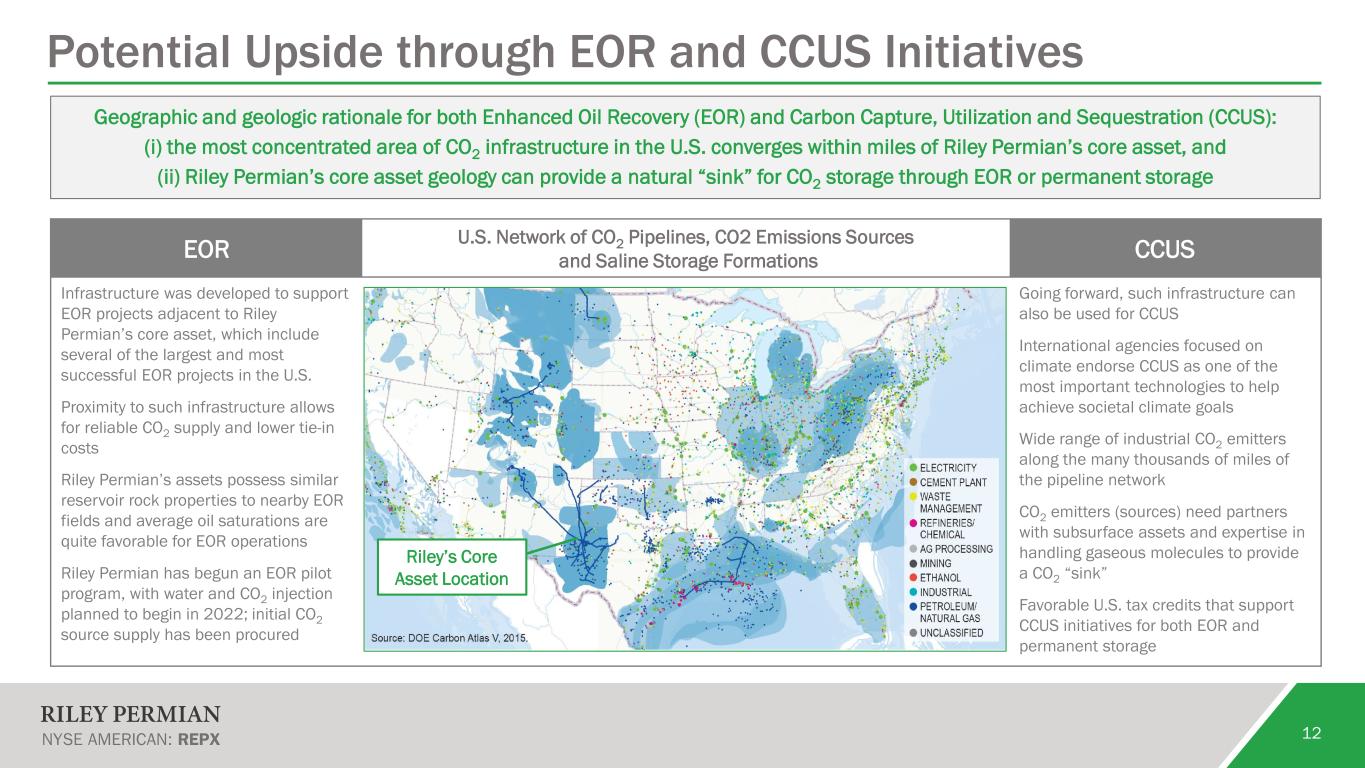
EOR U.S. Network of CO2 Pipelines, CO2 Emissions Sources and Saline Storage Formations CCUS Infrastructure was developed to support EOR projects adjacent to Riley Permian’s core asset, which include several of the largest and most successful EOR projects in the U.S. Proximity to such infrastructure allows for reliable CO2 supply and lower tie-in costs Riley Permian’s assets possess similar reservoir rock properties to nearby EOR fields and average oil saturations are quite favorable for EOR operations Riley Permian has begun an EOR pilot program, with water and CO2 injection planned to begin in 2022; initial CO2 source supply has been procured Going forward, such infrastructure can also be used for CCUS International agencies focused on climate endorse CCUS as one of the most important technologies to help achieve societal climate goals Wide range of industrial CO2 emitters along the many thousands of miles of the pipeline network CO2 emitters (sources) need partners with subsurface assets and expertise in handling gaseous molecules to provide a CO2 “sink” Favorable U.S. tax credits that support CCUS initiatives for both EOR and permanent storage Potential Upside through EOR and CCUS Initiatives 12 Geographic and geologic rationale for both Enhanced Oil Recovery (EOR) and Carbon Capture, Utilization and Sequestration (CCUS): (i) the most concentrated area of CO2 infrastructure in the U.S. converges within miles of Riley Permian’s core asset, and (ii) Riley Permian’s core asset geology can provide a natural “sink” for CO2 storage through EOR or permanent storage Riley’s Core Asset Location
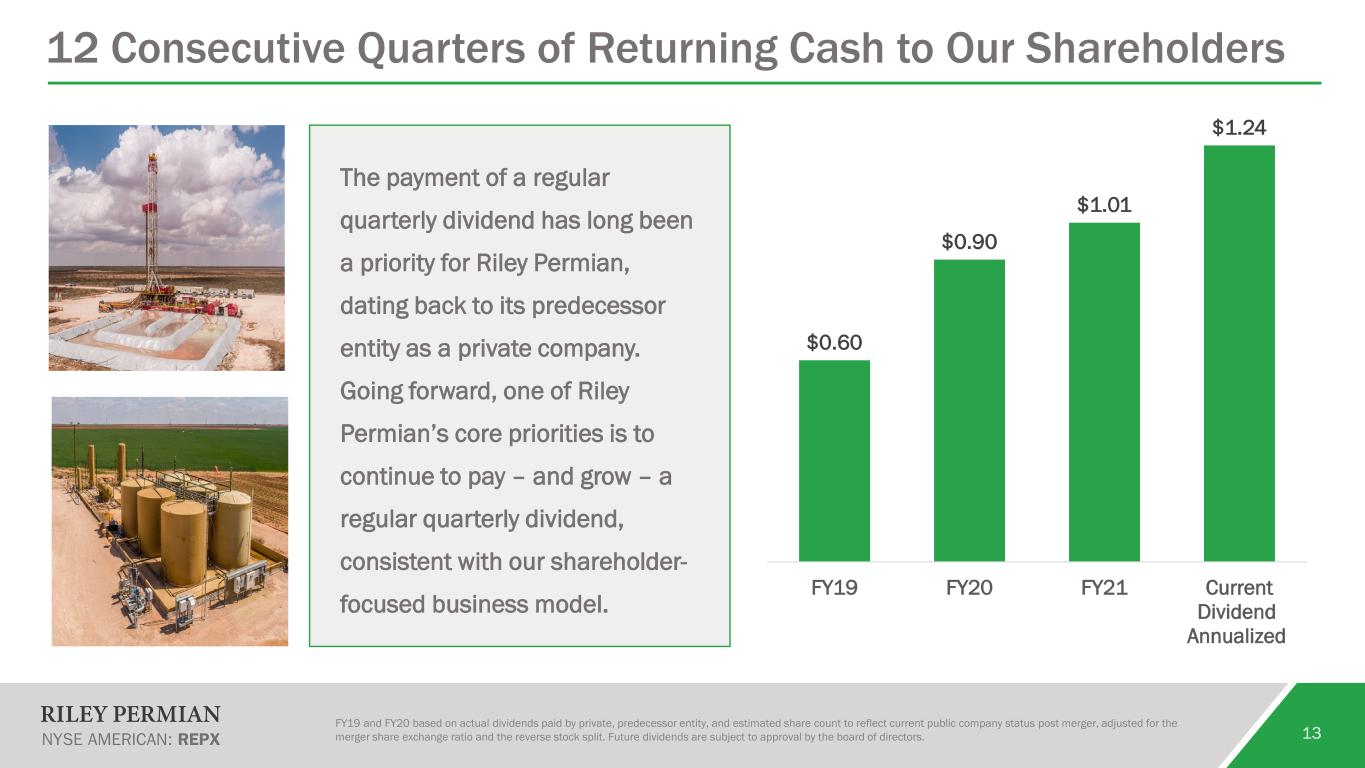
12 Consecutive Quarters of Returning Cash to Our Shareholders 13 FY19 and FY20 based on actual dividends paid by private, predecessor entity, and estimated share count to reflect current public company status post merger, adjusted for the merger share exchange ratio and the reverse stock split. Future dividends are subject to approval by the board of directors. The payment of a regular quarterly dividend has long been a priority for Riley Permian, dating back to its predecessor entity as a private company. Going forward, one of Riley Permian’s core priorities is to continue to pay – and grow – a regular quarterly dividend, consistent with our shareholder- focused business model. $0.60 $0.90 $1.01 $1.24 FY19 FY20 FY21 Current Dividend Annualized
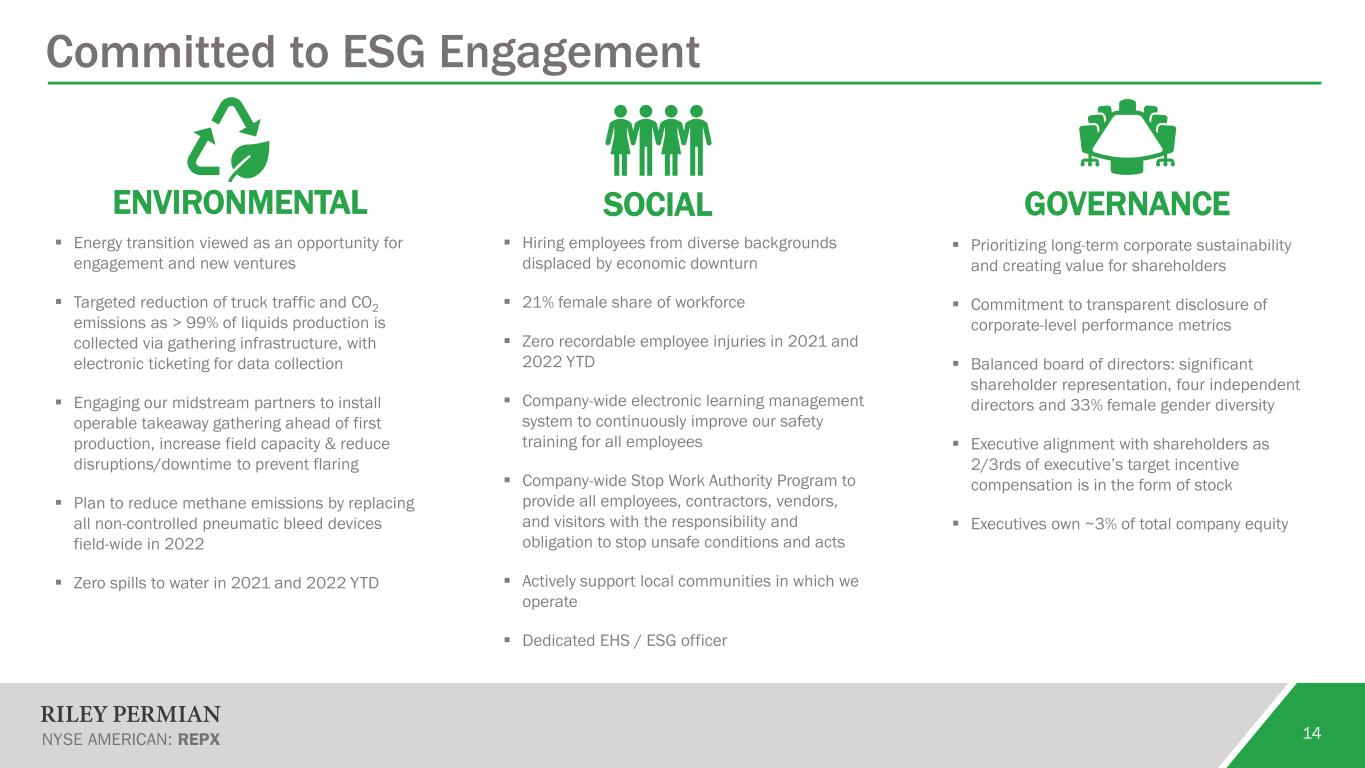
Committed to ESG Engagement 14 Energy transition viewed as an opportunity for engagement and new ventures Targeted reduction of truck traffic and CO2 emissions as > 99% of liquids production is collected via gathering infrastructure, with electronic ticketing for data collection Engaging our midstream partners to install operable takeaway gathering ahead of first production, increase field capacity & reduce disruptions/downtime to prevent flaring Plan to reduce methane emissions by replacing all non-controlled pneumatic bleed devices field-wide in 2022 Zero spills to water in 2021 and 2022 YTD Hiring employees from diverse backgrounds displaced by economic downturn 21% female share of workforce Zero recordable employee injuries in 2021 and 2022 YTD Company-wide electronic learning management system to continuously improve our safety training for all employees Company-wide Stop Work Authority Program to provide all employees, contractors, vendors, and visitors with the responsibility and obligation to stop unsafe conditions and acts Actively support local communities in which we operate Dedicated EHS / ESG officer Prioritizing long-term corporate sustainability and creating value for shareholders Commitment to transparent disclosure of corporate-level performance metrics Balanced board of directors: significant shareholder representation, four independent directors and 33% female gender diversity Executive alignment with shareholders as 2/3rds of executive’s target incentive compensation is in the form of stock Executives own ~3% of total company equity ENVIRONMENTAL SOCIAL GOVERNANCE
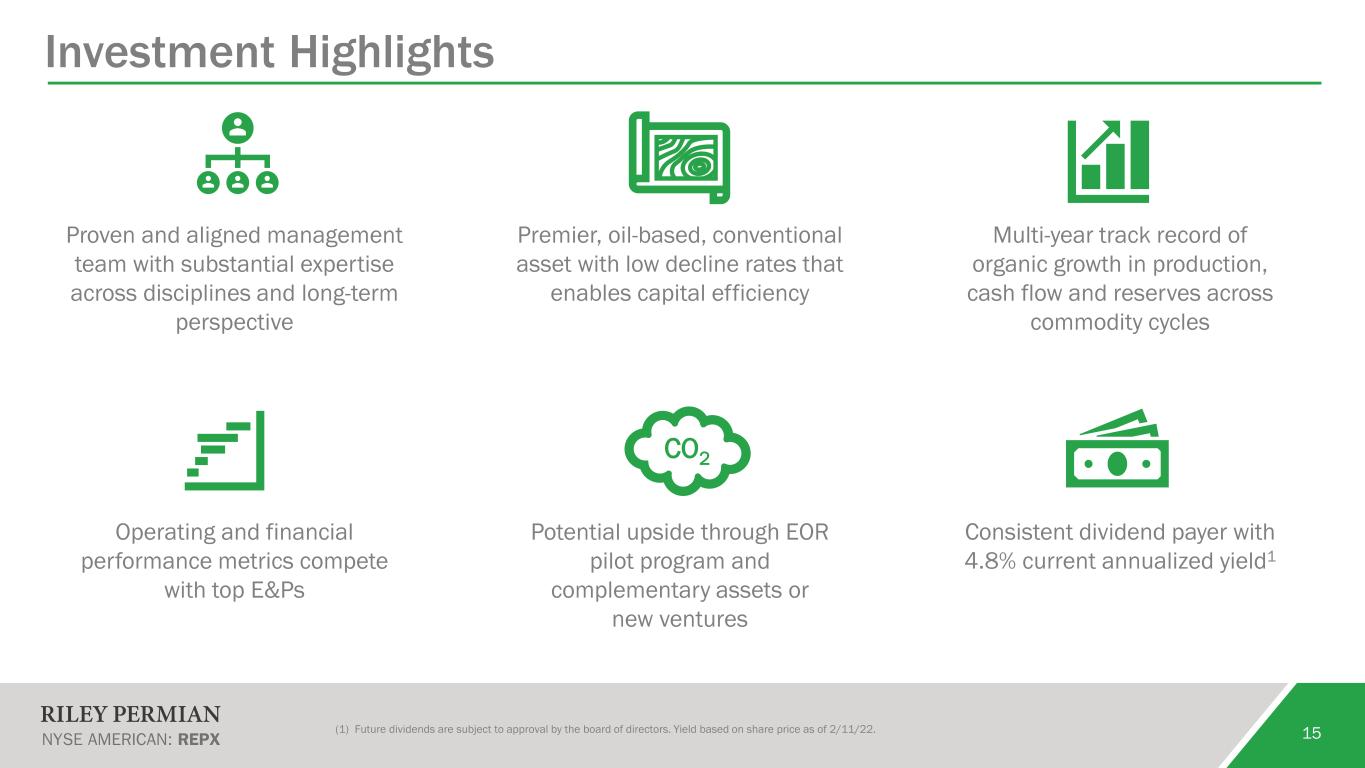
CO2 Investment Highlights 15(1) Future dividends are subject to approval by the board of directors. Yield based on share price as of 2/11/22. Proven and aligned management team with substantial expertise across disciplines and long-term perspective Premier, oil-based, conventional asset with low decline rates that enables capital efficiency Multi-year track record of organic growth in production, cash flow and reserves across commodity cycles Operating and financial performance metrics compete with top E&Ps Potential upside through EOR pilot program and complementary assets or new ventures Consistent dividend payer with 4.8% current annualized yield1
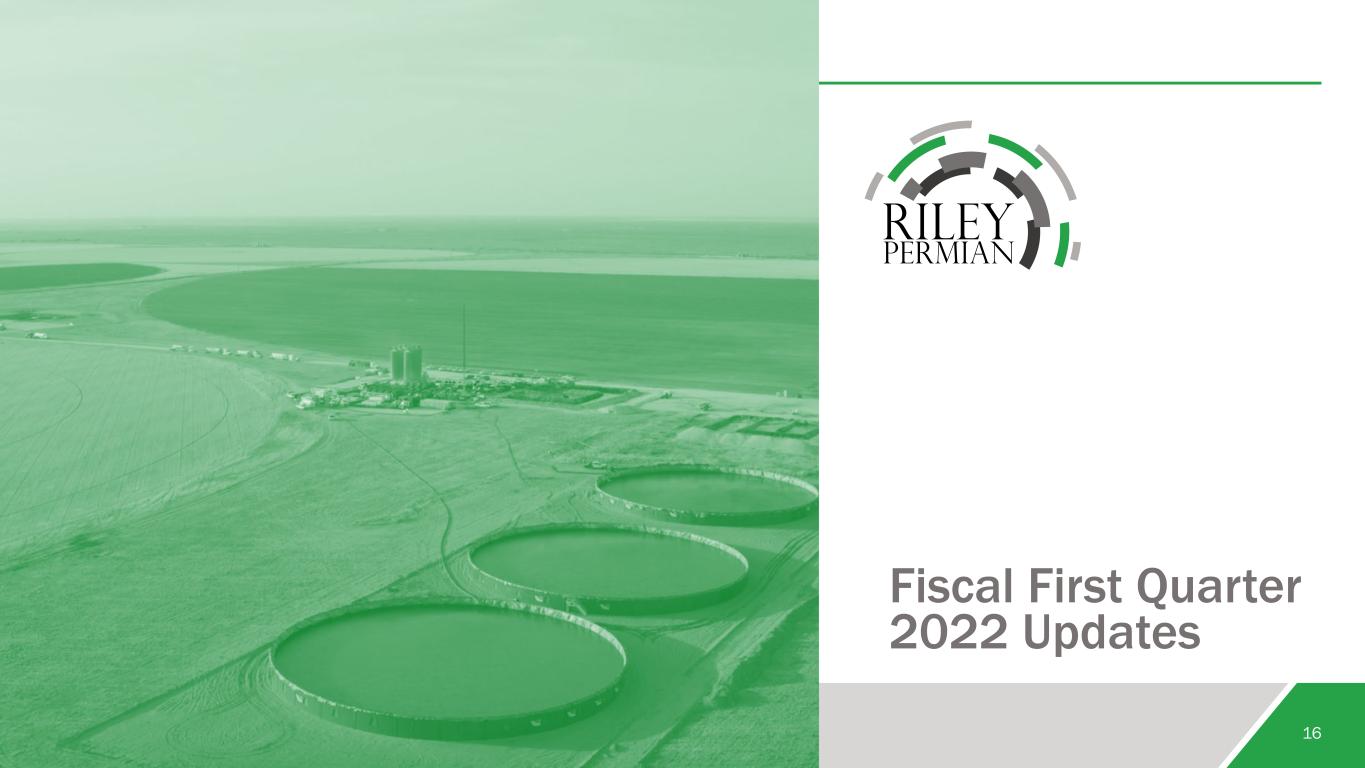
Fiscal First Quarter 2022 Updates 16[ insert footnotes here ]

17 Forward Guidance Quarter Only FQ2 22 Full-Year FY22 New This Quarter Unchanged from Prior Non-EOR Capex (Accrual Method) $20 - 24MM $65 - 71MM EOR Capex (Accrual Method) $6 - 8MM $20 - 24MM Total Capex (Accrual Method) $26 - 32MM $85 - 95MM Avg. Daily Oil Production, MBbls/d 7.25 - 7.50 11 - 15% year-over-year growthAvg. Daily Equivalent Production, MBoe/d 9.4 - 10.0 LOE, $MM $6.5MM - $8.0MM Cash G&A(1), $MM $3.5MM - $4.5MM (1) Non-GAAP financial measure. Excludes share-based compensation expense; includes the effect of gross profit from contract services derived from management services agreements.

Forecasted PDP and Growth Production Midpoint FY22 Capital Budget 0 3 6 9 12 Oct-21 Dec-21 Feb-22 Apr-22 Jun-22 Aug-22 N et M Bo e/ D PDP Maintenance Non-EOR Growth 18 Forecasted Production and Capital Budget -21% Base Decline +11-15% Base Decline per management estimates and NSAI reserve reports. Forecasted capital budget and production growth based on current market conditions and outlook, as of December 2021. Maintenance & Infrastructure Capital includes approximately $39MM for new wells, $6MM for capitalized workovers and $5MM for estimated infrastructure needs.

Calendar Qtrs. 4Q21 1Q22 2Q22 3Q22 4Q22 Update on Riley’s EOR Pilot Project 19 Completed • Regulatory permits • Drilling / casing of all six vertical injection wells, including logging and geoscience interpretation • Kinder Morgan agreements In Process or Upcoming • Water and gas line infrastructure ~95% complete • Recycle compressors ordered • Kinder Morgan tap installation in process with middle to late summer 2022 in-service date • Potential to augment natural CO2 from Kinder Morgan with industrial CO2 in this or subsequent project areas Injection Timing • Water injection forecasted to begin during March 2022 (earlier than prior guidance) • Combination of water and CO2 injection (alternating) to begin by middle to late summer 2022 Permits Injection Wells Infrastructure Buildout Begin Water Injection Begin C02 + Water Injection Completed In Process or Upcoming
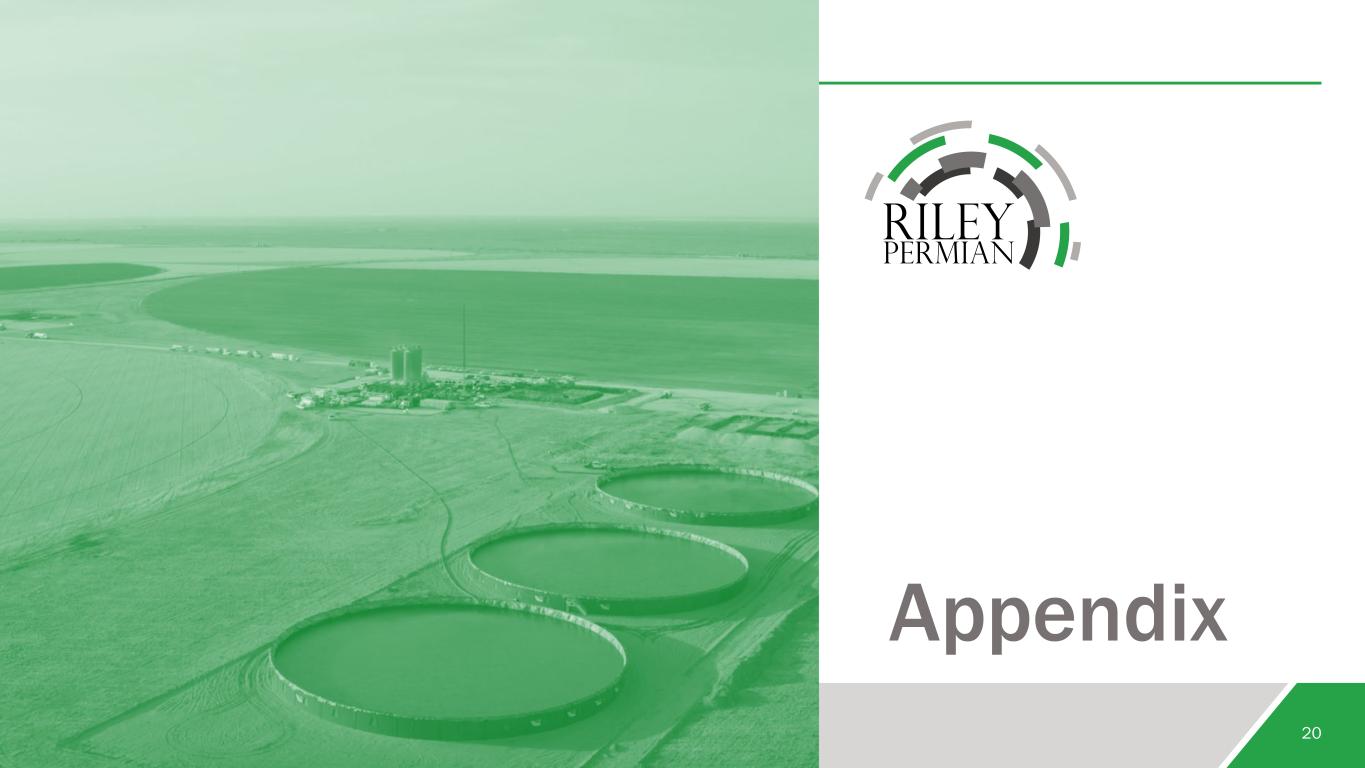
Appendix 20[ insert footnotes here ]
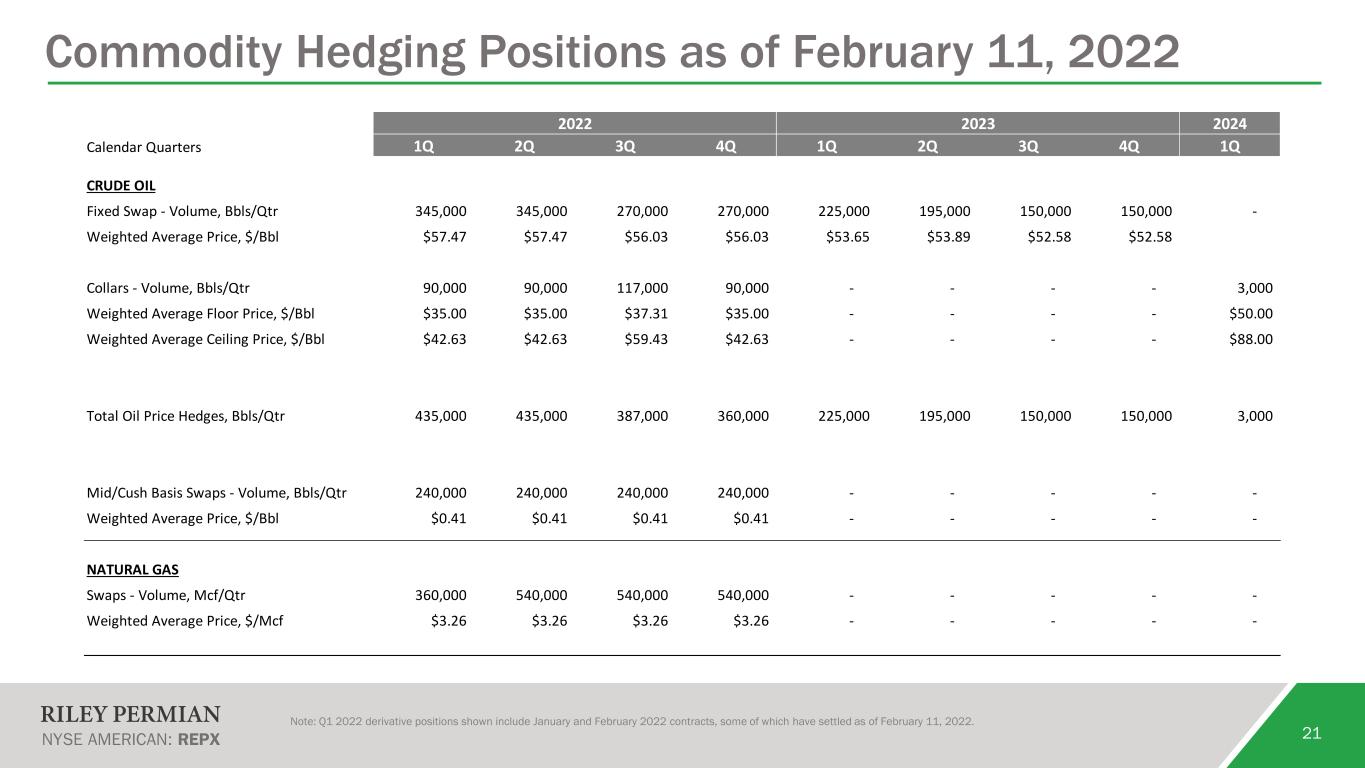
21 Commodity Hedging Positions as of February 11, 2022 Note: Q1 2022 derivative positions shown include January and February 2022 contracts, some of which have settled as of February 11, 2022. 2022 2023 2024 Calendar Quarters 1Q 2Q 3Q 4Q 1Q 2Q 3Q 4Q 1Q CRUDE OIL Fixed Swap - Volume, Bbls/Qtr 345,000 345,000 270,000 270,000 225,000 195,000 150,000 150,000 - Weighted Average Price, $/Bbl $57.47 $57.47 $56.03 $56.03 $53.65 $53.89 $52.58 $52.58 Collars - Volume, Bbls/Qtr 90,000 90,000 117,000 90,000 - - - - 3,000 Weighted Average Floor Price, $/Bbl $35.00 $35.00 $37.31 $35.00 - - - - $50.00 Weighted Average Ceiling Price, $/Bbl $42.63 $42.63 $59.43 $42.63 - - - - $88.00 Total Oil Price Hedges, Bbls/Qtr 435,000 435,000 387,000 360,000 225,000 195,000 150,000 150,000 3,000 Mid/Cush Basis Swaps - Volume, Bbls/Qtr 240,000 240,000 240,000 240,000 - - - - - Weighted Average Price, $/Bbl $0.41 $0.41 $0.41 $0.41 - - - - - NATURAL GAS Swaps - Volume, Mcf/Qtr 360,000 540,000 540,000 540,000 - - - - - Weighted Average Price, $/Mcf $3.26 $3.26 $3.26 $3.26 - - - - -

22 Non-GAAP Reconciliations The Company presents certain non-GAAP financial measures to supplement its financial statements prepared in accordance with accounting principles generally accepted in the United States (“GAAP”). The non-GAAP financial measures include Adjusted Net Income, Adjusted EBITDAX, Cash G&A, Cash Costs and Cash Margin and Free Cash Flow. A reconciliation of each non-GAAP measure to the most directly comparable GAAP financial measure is presented below. We believe that these non-GAAP measures presented, in conjunction with our financial and operating results prepared in accordance with GAAP, provide a more complete understanding of the Company’s performance. We use these non-GAAP measures to compare our financial and operating performance with that of other companies in the oil and natural gas industry as well as our financial and operating performance for current and historical periods. These non-GAAP measures should not be considered in isolation or as a substitute for GAAP measures, such as net income (loss), operating income (loss), total costs and expenses, general and administrative expenses or net cash provided by operating activities or any other GAAP measure of financial position or results of operations. As not all companies use the same calculation, our non-GAAP measures may not be comparable to similarly titled measures presented by other companies.
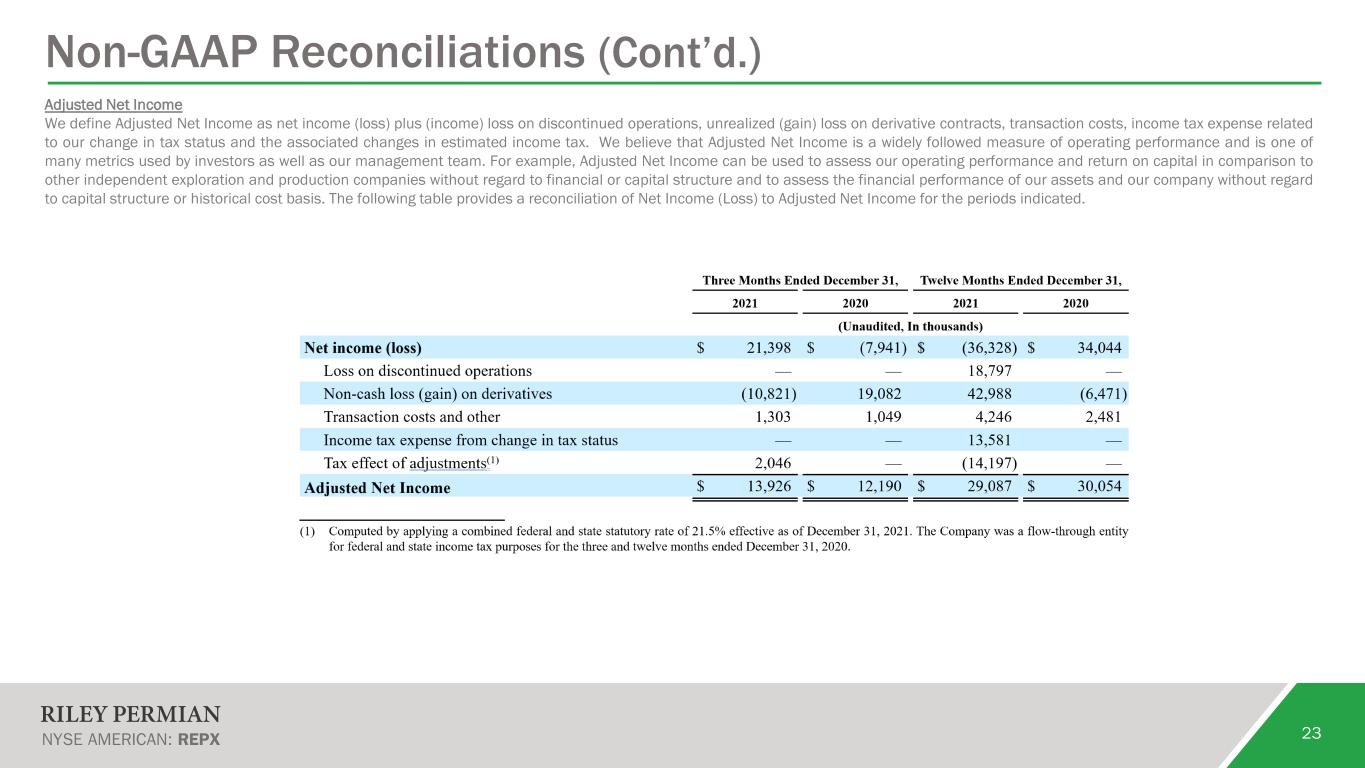
23 Non-GAAP Reconciliations (Cont’d.) Adjusted Net Income We define Adjusted Net Income as net income (loss) plus (income) loss on discontinued operations, unrealized (gain) loss on derivative contracts, transaction costs, income tax expense related to our change in tax status and the associated changes in estimated income tax. We believe that Adjusted Net Income is a widely followed measure of operating performance and is one of many metrics used by investors as well as our management team. For example, Adjusted Net Income can be used to assess our operating performance and return on capital in comparison to other independent exploration and production companies without regard to financial or capital structure and to assess the financial performance of our assets and our company without regard to capital structure or historical cost basis. The following table provides a reconciliation of Net Income (Loss) to Adjusted Net Income for the periods indicated.

24 Non-GAAP Reconciliations (Cont’d.) Adjusted EBITDAX We define Adjusted EBITDAX as net income (loss) adjusted for loss (income) on discontinued operations, exploration expense, depletion, depreciation, amortization and accretion, equity-based compensation expense, interest expense, unrealized (gain) loss on commodity derivative contracts, income taxes, and transaction costs. We believe Adjusted EBITDAX is useful to investors because it provides an effective way to evaluate our operating performance and compare the results of our operations from period to period as well as to other companies in the oil and natural gas industry without regard to our financing methods or capital structure. The following table provides a reconciliation from the GAAP measure of Net income (loss) to Adjusted EBITDAX.
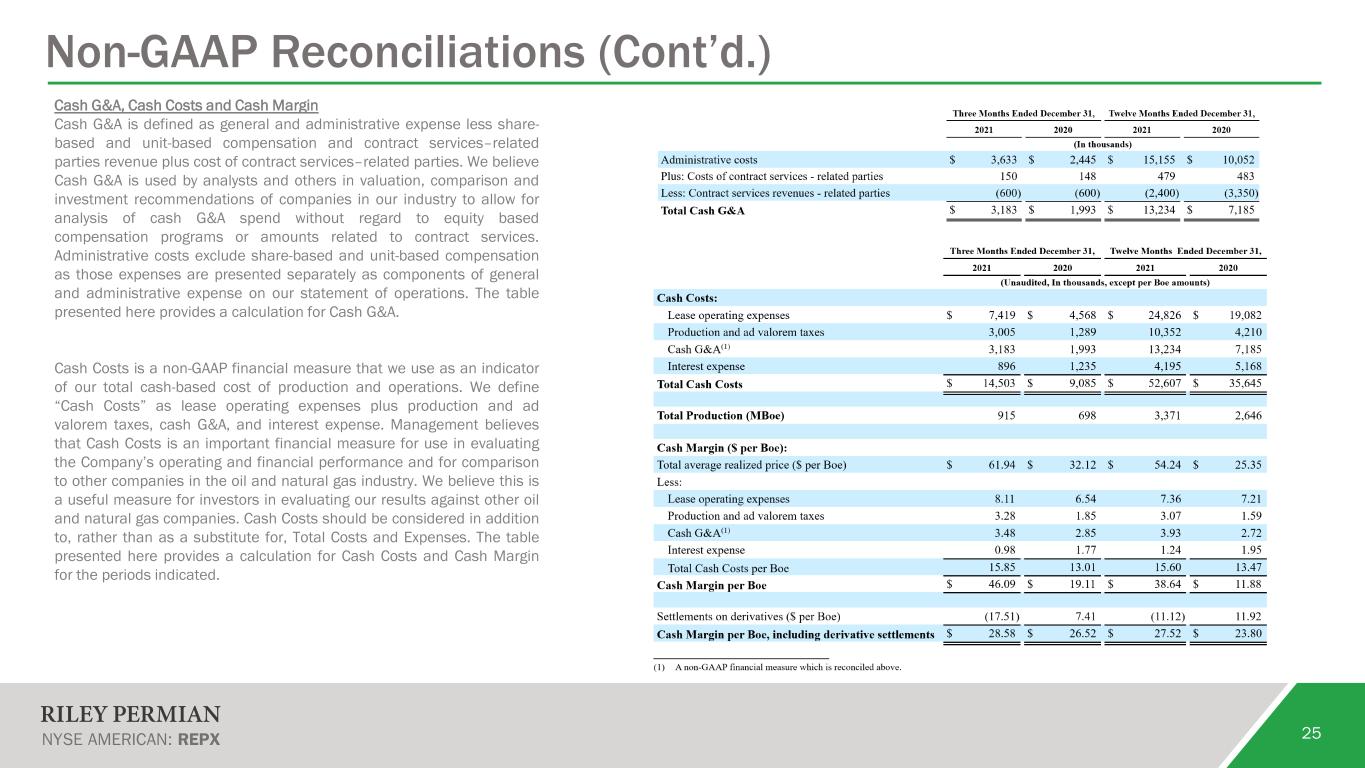
25 Non-GAAP Reconciliations (Cont’d.) Cash G&A, Cash Costs and Cash Margin Cash G&A is defined as general and administrative expense less share- based and unit-based compensation and contract services–related parties revenue plus cost of contract services–related parties. We believe Cash G&A is used by analysts and others in valuation, comparison and investment recommendations of companies in our industry to allow for analysis of cash G&A spend without regard to equity based compensation programs or amounts related to contract services. Administrative costs exclude share-based and unit-based compensation as those expenses are presented separately as components of general and administrative expense on our statement of operations. The table presented here provides a calculation for Cash G&A. Cash Costs is a non-GAAP financial measure that we use as an indicator of our total cash-based cost of production and operations. We define “Cash Costs” as lease operating expenses plus production and ad valorem taxes, cash G&A, and interest expense. Management believes that Cash Costs is an important financial measure for use in evaluating the Company’s operating and financial performance and for comparison to other companies in the oil and natural gas industry. We believe this is a useful measure for investors in evaluating our results against other oil and natural gas companies. Cash Costs should be considered in addition to, rather than as a substitute for, Total Costs and Expenses. The table presented here provides a calculation for Cash Costs and Cash Margin for the periods indicated.

26 Non-GAAP Reconciliations (Cont’d.) Free Cash Flow Free Cash Flow is a measure that we use as an indicator of our ability to fund our development activities and generate excess cash for other corporate purposes. We define Free Cash Flow as Cash Flow from Continuing Operations, less capital expenditures before acquisitions. Free Cash Flow should be considered in addition to, rather than as a substitute for, net cash provided by operating activities as a measure of our liquidity. The following table provides a reconciliation of Net Cash Provided by Operating Activities - Continuing Operations to Free Cash Flow for the periods indicated.
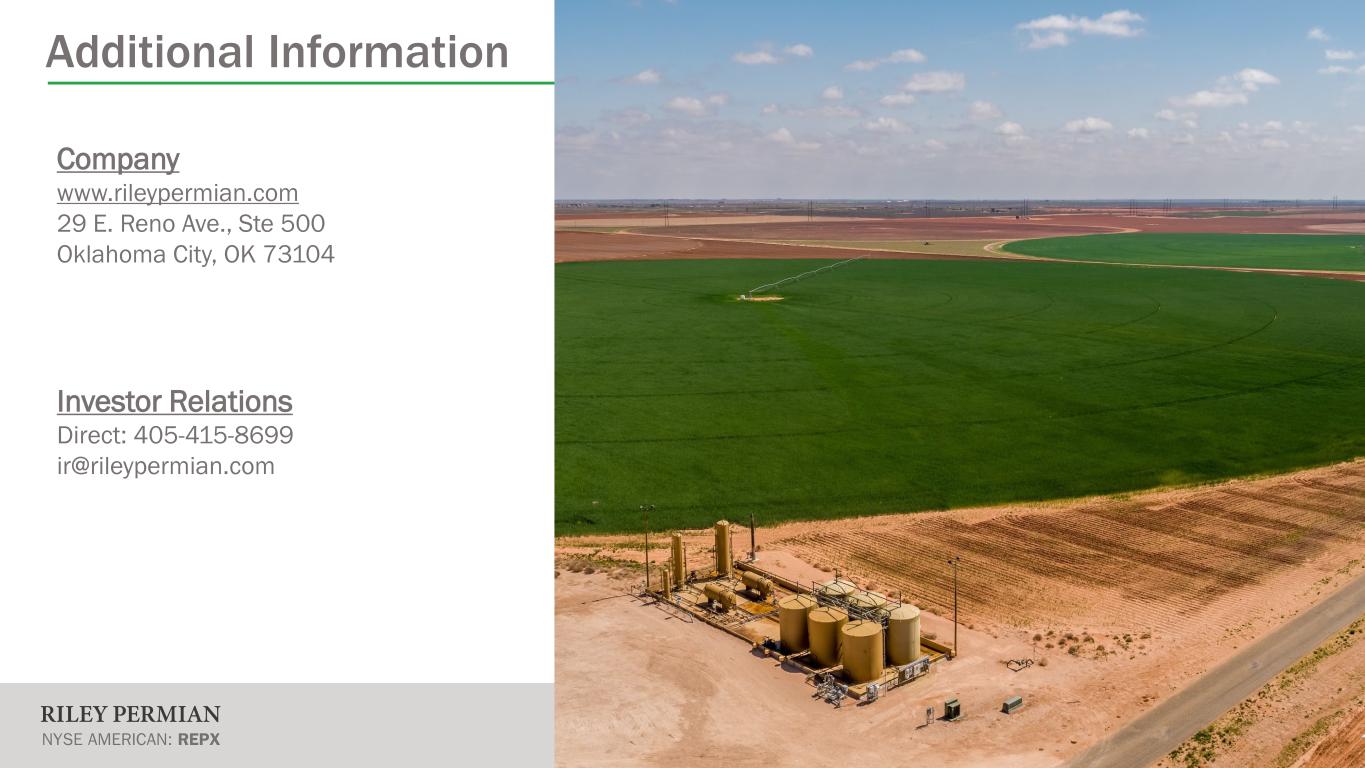
Additional Information 27 Company www.rileypermian.com 29 E. Reno Ave., Ste 500 Oklahoma City, OK 73104 Investor Relations Direct: 405-415-8699 ir@rileypermian.com


























